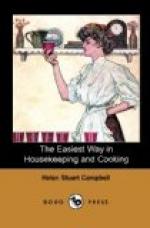MINCE-MEAT FOR PIES.
Two pounds of cold roast or boiled beef, or a small beef-tongue, boiled the day beforehand, cooled and chopped; one pound of beef-suet, freed from all strings, and chopped fine as powder; two pounds of raisins stoned and chopped; one pound of currants washed and dried; six pounds of chopped apples; half a pound of citron cut in slips; two pounds of brown sugar; one pint of molasses; one quart of boiled cider; one pint of wine or brandy, or a pint of any nice sirup from sweet pickles may be substituted; two heaping tablespoonfuls of salt; one teaspoonful of pepper; three tablespoonfuls of ground cinnamon; two of allspice; one of clove; one of mace; three grated nutmegs; grated rind and juice of three lemons; a cupful of chopped, candied orange or lemon peel.
Mix spices and salt with sugar, and stir into the meat and suet. Add the apples, and then the cider and other wetting, stirring very thoroughly. Lastly, mix in the fruit. Fill and bake as in apple pies. This mince-meat will keep two months easily. If it ferments at all, put over the fire in a porcelain-lined kettle, and boil half an hour. Taste, and judge for yourselves whether more or less spice is needed. Butter can be used instead of suet, and proportions varied to taste.
RAMMEKINS, OR CHEESE STRAWS.
One pound of puff paste; one cup of good grated cheese. Roll the paste half an inch thick; sprinkle on half the cheese; press in lightly with the rolling-pin; roll up, and roll out again, using the other half of the cheese. Fold, and roll about a third of an inch thick. Cut in long, narrow strips, four or five inches long and half an inch wide, and bake in a quick oven to a delicate brown. Excellent with chocolate at lunch, or for dessert with fruit.
* * * * *
PUDDINGS BOILED AND BAKED.
For boiled puddings a regular pudding-boiler holding from three pints to two quarts is best, a tin pail with a very tight-fitting cover answering instead, though not as good. For large dumplings a thick pudding-cloth—the best being of Canton flannel, used with the nap-side out—should be dipped in hot water, and wrung out, dredged evenly and thickly with flour, and laid over a large bowl. From half to three-quarters of a yard square is a good size. In filling this, pile the fruit or berries on the rolled-out crust which has been laid in the middle of the cloth, and gather the edges of the paste evenly over it. Then gather the cloth up, leaving room for the dumpling to swell, and tying very tightly. In turning out, lift to a dish; press all the water from the ends of the cloth; untie and turn away from the pudding, and lay a hot dish upon it, turning over the pudding into it, and serving at once, as it darkens or falls by standing.
In using a boiler, butter well, and fill only two-thirds full that the mixture may have room to swell. Set it in boiling water, and see that it is kept at the same height, about an inch from the top. Cover the outer kettle that the steam may be kept in. Small dumplings, with a single apple or peach in each, can be cooked in a steamer. Puddings are not only much more wholesome, but less expensive than pies.




